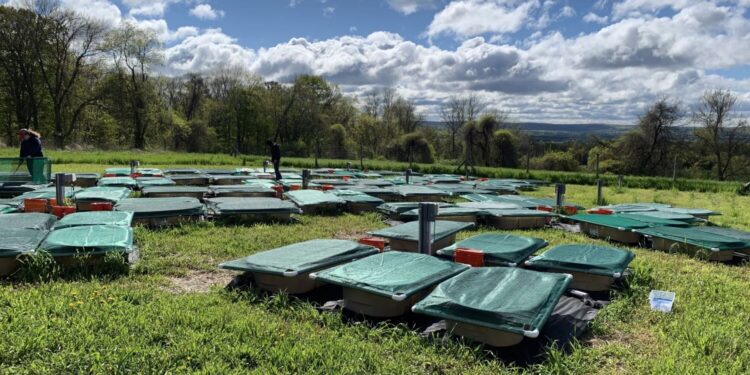Setup a research tank, each with a population of wood frog tadpoles inside. Credit: Meghan Parsely
Tracy Rittenhouse, associate professor of natural resources and environment in UConn’s College of Agriculture, Health and Natural Resources (CAHNR), was conducting an experiment to study ranavirus outbreaks in wood frogs. When Meghan Parsley, then a Ph.D. student at Washington State University heard about it, she realized that this approach would also be ideal for studying some questions she had about environmental DNA (eDNA).
The two connected and began collaborating to answer several scientific questions through an experiment conducted at UConn.
“This project came about by chance in a really wonderful way,” says Rittenhouse. “This has been a great collaboration between UConn and Washington State University.”
Environmental DNA, also known as eDNA, is genetic material from animals and plants that scientists can use to determine what types of organisms live in an environment. However, scientists cannot currently use eDNA reliably to estimate how many animals of a given species are present in the environment, especially in smaller populations. Indeed, a multitude of factors can influence eDNA concentrations that have nothing to do with the number of populations.
“One thing we’ve learned over the last few years from eDNA is that we can detect pretty well whether species are present or not,” says Parsley. “But the next question we always get from people who are on the ground doing conservation or management work is, ‘How many are there?’ And we must always say that we don’t know. »
Traditionally, scientists have had to capture, mark, release and recapture animals to estimate population sizes. This requires a lot of time, money and resources, making eDNA, which has been gaining popularity for more than a decade, a promising alternative if it can be made more reliable.
“How to estimate population size is really the backbone of wildlife research,” says Rittenhouse. “The number one question every wildlife biologist gets asked is how many animals are there?”
Rittenhouse’s experiment created a series of ranavirus outbreaks in the experimental frog population to better understand the impact of this common disease on wild frog populations. The experiment included 120 tanks with two environmental variables, high temperature and high salinity, which represented climate change and road salt runoff in nature, respectively. The research team replicated the experiment several times.
Influence plot showing the hypothetical impact (+/−) of each experimental treatment on eDNA production and degradation rates leading to wood frog eDNA concentrations collected in sampled mesocosms. RV = Ranavirus. Credit: Scientific reports (2024). DOI: 10.1038/s41598-024-66732-4
“When I study a species found in Connecticut or in this region of the world, I ask ‘what is the conservation problem for this particular species?’” Rittenhouse says. “For wood frogs, we know that ranavirus outbreaks occur in the wild, but we don’t know how often or where. So the big conservation problem for this species is its susceptibility to ranavirus.
Rittenhouse has an upcoming publication sharing his findings from this study and is currently analyzing the results on how tadpole densities affected outbreaks.
During this time, Parsley set out to study the impact of environmental factors on the amount of eDNA produced by each organism as well as how quickly eDNA degrades in the environment.
She found that higher temperatures were associated with a decrease in the amount of eDNA in the early stages of the outbreak. However, when the disease progressed to advanced stages, environmental factors did not have a significant impact, but the increasing number of dead organisms, resulting from the progression of the epidemic, contributed more to the eDNA.
These results were published in Scientific reports with co-authors Caren Goldberg, Erica Crespi and Jesse Brunner of Washington State University.
The researchers found that environmental conditions and outbreak status strongly influenced the eDNA of these frog populations. But due to the high levels of variation in eDNA quantities that do not have a close relationship with eDNA and population size, they are unsure of the accuracy of the approach.
“This led us to question how accurate eDNA can be in discerning smaller or narrower population sizes, which may be important in some conservation or management contexts,” says Parsley. “eDNA could more easily detect large population differences, such as 1,000 versus 10 organisms, that can occur in natural populations.”
A problem with the accuracy of this method may be sample-to-sample variation. When researchers take a sample of eDNA, they are just taking water from the environment. Alternative sampling methods can help mitigate this variation, an issue Parsley addresses in an upcoming publication.
“I think one of the main takeaways is that environmental factors impact DNA concentrations in the environment and we should be aware of that,” Parsley says.
More information:
Meghan B. Parsley et al, Environmental DNA concentrations vary significantly across productive and degrading conditions, with implications for the accuracy of population estimates, Scientific reports (2024). DOI: 10.1038/s41598-024-66732-4
Provided by University of Connecticut
Quote: Environmental DNA and outbreaks in wood frogs: Collaboration examines the accuracy of eDNA in estimating population size (October 17, 2024) retrieved October 17, 2024 from
This document is subject to copyright. Except for fair use for private study or research purposes, no part may be reproduced without written permission. The content is provided for informational purposes only.



